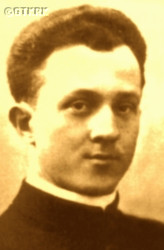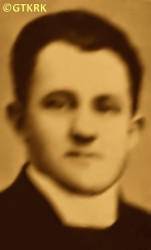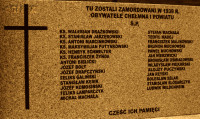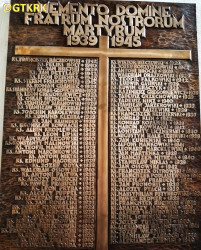Roman Catholic
St Sigismund parish
05-507 Słomczyn
85 Wiślana Str.
Konstancin deanery
Warsaw archdiocese, Poland
full list:
displayClick to display full list

searchClick to search full list by categories
wyświetlKliknij by wyświetlić pełną listę po polsku

szukajKliknij by przeszukać listę wg kategorii po polsku

Martyrology of the clergy — Poland
XX century (1914 – 1989)
personal data
surname
MARCINKOWSKI
forename(s)
Anthony (pl. Antoni)
function
diocesan priest
creed
Latin (Roman Catholic) Church RCmore on
en.wikipedia.org
[access: 2014.09.21]
diocese / province
Culm (Chełmno) diocesemore on
pl.wikipedia.org
[access: 2012.11.23]
date and place
of death
01.11.1939

Klamrytoday: Chełmno gm., Chełmno pov., Kuyavia‐Pomerania voiv., Poland
more on
en.wikipedia.org
[access: 2021.12.18]
alt. dates and places
of death
Małe Czystetoday: Stolno gm., Chełmno pov., Kuyavia‐Pomerania voiv., Poland
more on
en.wikipedia.org
[access: 2021.12.18]
Sarnowotoday: Stolno gm., Chełmno pov., Kuyavia‐Pomerania voiv., Poland
more on
en.wikipedia.org
[access: 2021.09.02]
details of death
During World War I, in the years 1914‐1918, a soldier of the German Imperial Army (called up immediately after graduating from gymnasium).
After German and Russian invasion of Poland in 09.1939 and start of the World War II, after start of German occupation, arrested by the Germans on 30.10.1939, together with his vicar, Fr Joseph Ryngwelski.
Held in the basement of the Commune Office in Rybakowo (c. 3 km from the Sarnowo parish), and then in Chełmno (15 km from Rybakowo).
From there taken to the execution site and murdered in a mass execution.
His name is on the commemorative monument in Klamry.
The murder was committed in the middle of the forest known as „Rybieniec” — more precisely, a forest complex, c. 6 km from Chełmno, stretching latitudinally, on the west‐east axis, for c. 12 km (neighboring, among others, the villages of Klamry, Rybieniec, Wabcz, Paparzyn) — not far from the former Fort VIII of the Prussian Chełmno Fortress, where the Germans organized a makeshift concentration camp for Poles, i.e. a part of VSH Culm detention center, which also included other places of internment of Poles in Chełmno. The arrests and murders were carried out by members of the German, genocidal Germ. Volksdeutscher Selbstschutz (Eng. Ethnic German Self‐Defense) — a paramilitary formation composed of representatives of the German national minority in Poland — prob. with the support of genocidal Germ. SS‐Einsatzgruppen (Eng. SS Operational Groups), a formation organized and directed by the German Reichssicherheitshauptamt (Eng. Reich Main Security Office), i.e. RSHA. The condemned were brought to the murder site three times a day. They were murdered using machine guns.
From 12.10.1939 to 11.11.1939, the Germans murdered — as part of the Germ.«Intelligenzaktion» (Eng. „Action Intelligence”), i.e. the German program of extermination of the Polish elite, mainly the intelligentsia and leadership classes — c. 2,000‐2,500 inhabitants of the Chełmno region, mainly Polish intelligentsia, in mass executions in Klamry. Among the executed were teachers (at least 21), officials, engineers, craftsmen, farmers, a dozen or so Catholic priests, and political and social activists.
In the second half of 1944, as the German‐Russian front approached, as part of the Germ. „Sonderaktion 1005” (Eng. „Special Action 1005”) — using a group of Jewish prisoners known as Germ. „Leichenkommandos” (Eng. „Corpses' Units”) — the Germans dug up and burned the corpses. After that, the Jews were murdered.
alt. details of death
According to some sources murdered in Małe Czyste (n. Chełmno), according to yet others murdered in a forests by Sarnowo beaten up to death with shovels.
cause of death
mass murder
perpetrators
Germans
sites and events
Małe CzysteClick to display the description, VSH CulmClick to display the description, «Intelligenzaktion»Click to display the description, Reichsgau Danzig‐WestpreußenClick to display the description, Ribbentrop‐MolotovClick to display the description, Pius XI's encyclicalsClick to display the description
date and place
of birth
27.10.1893Birth certification on:
www.genealogiawarchiwach.pl
[access: 2025.09.29]

Toruńtoday: Toruń city pov., Kuyavia‐Pomerania voiv., Poland
more on
en.wikipedia.org
[access: 2021.06.20]
parents
MARCINKOWSKI John
🞲 ?, ? — 🕆 ?, ?

DELEWSKA Valerie
🞲 ?, ? — 🕆 ?, ?
presbyter (holy orders)
ordination
17.06.1923

Pelplintoday: Pelplin gm., Tczew pov., Pomerania voiv., Poland
more on
en.wikipedia.org
[access: 2021.05.06]
St Barbara RC chapelmore on
pl.wikipedia.org
[access: 2021.12.19] (in Theological Seminary)
positions held
1936 – 1939
parish priest — Sarnowotoday: Stolno gm., Chełmno pov., Kuyavia‐Pomerania voiv., Poland
more on
en.wikipedia.org
[access: 2021.09.02] ⋄ St Martin the Bishop and Confessor RC parish ⋄ Chełmnotoday: Chełmno urban gm., Chełmno pov., Kuyavia‐Pomerania voiv., Poland
more on
en.wikipedia.org
[access: 2021.07.25] RC deanery — also: inspector of religious education in elementary schools
1933 – 1936
parish priest — GdyniaGrabówek district
today: Gdynia city pov., Pomerania voiv., Poland
more on
en.wikipedia.org
[access: 2021.09.02] ⋄ Holy Family RC parish ⋄ Gdyniatoday: Gdynia city pov., Pomerania voiv., Poland
more on
en.wikipedia.org
[access: 2021.09.02] RC deanery
1930 – 1933
activist — Poznańtoday: Poznań city pov., Greater Poland voiv., Poland
more on
en.wikipedia.org
[access: 2021.07.18] ⋄ Catholic Polish Youth Association ⋄ St Mary Magdalene RC collegiate parish ⋄ Poznańtoday: Poznań city pov., Greater Poland voiv., Poland
more on
en.wikipedia.org
[access: 2021.07.18] RC deanery — also: general secretary (c. 1932‐1933), member of the management board (from 1931), collaborator of the management board (c. 1930‐1931) and head of the secretariat and departments: personnel, reporting, internal, general technical; editor of the Union's magazine „Head of Youth Associations” (from 1930)
1929 – 1930
vicar — Toruńtoday: Toruń city pov., Kuyavia‐Pomerania voiv., Poland
more on
en.wikipedia.org
[access: 2021.06.20] ⋄ Assumption of the Blessed Virgin Mary RC parish ⋄ Toruńtoday: Toruń city pov., Kuyavia‐Pomerania voiv., Poland
more on
en.wikipedia.org
[access: 2021.06.20] RC deanery
1928
vicar — Jabłonowo Pomorskietoday: Jabłonowo Pomorskie gm., Brodnica pov., Kuyavia‐Pomerania voiv., Poland
more on
en.wikipedia.org
[access: 2021.09.02] ⋄ St Adalbert the Bishop and Martyr RC parish ⋄ Radzyńtoday: Radzyń Chełmiński, Radzyń Chełmiński gm., Grudziądz pov., Kuyavia‐Pomerania voiv., Poland
more on
en.wikipedia.org
[access: 2021.09.02] RC deanery
1927 – 1928
administrator — Jabłonowo Pomorskietoday: Jabłonowo Pomorskie gm., Brodnica pov., Kuyavia‐Pomerania voiv., Poland
more on
en.wikipedia.org
[access: 2021.09.02] ⋄ St Adalbert the Bishop and Martyr RC parish ⋄ Radzyńtoday: Radzyń Chełmiński, Radzyń Chełmiński gm., Grudziądz pov., Kuyavia‐Pomerania voiv., Poland
more on
en.wikipedia.org
[access: 2021.09.02] RC deanery — acting („ad interim”)
1923 – 1927
vicar — Chełmnotoday: Chełmno urban gm., Chełmno pov., Kuyavia‐Pomerania voiv., Poland
more on
en.wikipedia.org
[access: 2021.07.25] ⋄ Assumption of the Blessed Virgin Mary RC parish ⋄ Chełmnotoday: Chełmno urban gm., Chełmno pov., Kuyavia‐Pomerania voiv., Poland
more on
en.wikipedia.org
[access: 2021.07.25] RC deanery
1919 – 1923
student — Pelplintoday: Pelplin gm., Tczew pov., Pomerania voiv., Poland
more on
en.wikipedia.org
[access: 2021.05.06] ⋄ philosophy and theology, Theological Seminary
1914 – 1918
soldier — German Imperial Army
till 1914
pupil — Chełmnotoday: Chełmno urban gm., Chełmno pov., Kuyavia‐Pomerania voiv., Poland
more on
en.wikipedia.org
[access: 2021.07.25] ⋄ Germ. Königliche Katholische Gymnasium (Eng. Royal Catholic Gymnasium) — studies completed in 08.1914 with the maturity diploma (i.e. matura)
1906 – 1912
pupil — Pelplintoday: Pelplin gm., Tczew pov., Pomerania voiv., Poland
more on
en.wikipedia.org
[access: 2021.05.06] ⋄ „Collegium Marianum” progymnasium
others related
in death
BROCKIClick to display biography Anthony, DRĄŻKOWSKIClick to display biography Valerian, GREGORKIEWICZClick to display biography Leo, JARZĘBOWSKIClick to display biography Stanislav, MIĘTKIClick to display biography Anthony, ODYAClick to display biography Joseph Florian, PUTYNKOWSKIClick to display biography Maximilian John, RYNGWELSKIClick to display biography Joseph, SADOWSKIClick to display biography Anastasius, SCHMELTERClick to display biography Henry, SOWIŃSKIClick to display biography Emil Bronislav, WILCZEWSKIClick to display biography Francis Joseph, ŻYNDAClick to display biography Francis, KOPAŃSKIClick to display biography Conrad, GASIŃSKIClick to display biography Louis, NAGÓRSKIClick to display biography Edmund Marian, MARTENKAClick to display biography John, NIKLASClick to display biography Stanislav
sites and events
descriptions
Małe Czyste: From 09.1939 to 11.1939, Germans — representatives of the paramilitary organization Volksdeutscher Selbstschutz — in the former sand mine (Piaskownia) between the villages of Małe Czyste and Dorposz Szlachecki, in a series of mass executions, murdered c. 400‐800 inhabitants of the Chełmno county, mainly representatives of local Polish political and economic and intellectual elites — Catholic priests, teachers, officials, members of the Union of Veterans of National Uprisings of the Republic of Poland, the Society of Insurgents and Soldiers and Military Trainees. The victims — only c. 80 names are known — were brought to the place of execution usually at night. They were forced to dig pits (there were probably 6 graves in total, on an area of about 100 m2), and then shot over them in the light of car headlights. In 08.1944, the Germans, as part of the Germ. „Sonderaktion 1005” (Eng. „Special Action 1005”) — using groups of prisoners known as the Germ. „Leichenkommandos” (Eng. „Corpse Units”) — dug up the bodies of the murdered and then burned them. (more on: pl.wikipedia.orgClick to attempt to display webpage
[access: 2021.12.19], www.odznaka.kuj-pom.bydgoszcz.pttk.plClick to attempt to display webpage
[access: 2013.01.13])
VSH Culm: German Germ. Volksdeutscher Selbstschutzhaft (Eng. Volksdeutscher Selbstschutz custody) VSH, founded by the Germans in Chełmno. The main role in it was played by members of the genocidal paramilitary formation Germ. Volksdeutscher Selbstschutz — the decision to create Selbstschutz in the Polish lands occupied by German troops was made in Berlin on 08‐10.09.1939 at a conference headed by Reichsführer‐SS Heinrich Himmler (the formal order bears the data 20.09.1939), and the chaotically formed units were directly subordinated to the officers of the genocidal SS organization. As part of the «Intelligenzaktion» operation, i.e. the extermination of the Polish intelligentsia and leadership classes, the Germans held thousands of Poles in the court prison building in Chełmno, in temporary detention centers set up in the buildings of primary schools No. 1 and No. 2 in Chełmno, in a makeshift camp set up in the old Fort VIII in Klamry (part of the former Prussian Chełmno Fortress), and also from 10.1939 in the convent of the Daughters of Charity, i.e. the Grey Sisters FdlC in Chełmno (where from 07.12.1939 a dozen or so Polish priests were interned, brought mainly from the VSH Dembowalonka internment camp). A significant number of those held, including c. 19 Catholic priests, were murdered in Klamry; some were transported to the KL Stutthof concentration camp (including, on 22.03.1940, many Catholic priests who remained in custody, most of whom were also subsequently murdered). (more on: pl.wikipedia.orgClick to attempt to display webpage
[access: 2014.03.10])
«Intelligenzaktion»: German: «Intelligenzaktion» (English: „Intelligence Action”) — a German program of extermination of the Polish elite, mainly the intelligentsia and leadership layers, carried out from the beginning of the occupation in w 09.1939 to 04.1940, mainly in territories directly annexed to Germany, but also in the so‐called Germ. Generalgouvernement (Eng. General Governorate), where it was called «AB‐aktion». In the first phase, immediately after the beginning of the German occupation, during military operations carried out by the Germ. Wehrmacht (Eng. Armed Forces) and the genocidal units of the Germ. Einsatzgruppen (Eng. Operational Groups) of the Germ. Sicherheitspolizei (Eng. Security Police), i.e. SiPo, and Germ. Sicherheitsdienst des Reichsführers SS (Eng. Security Service of the Reichsführer SS), i.e. SD, organized by the Germ. Reichssicherheitshauptamt (Eng. Reich Main Security Office), i.e. RSHA, which followed the troops, carried out under the Germ. Unternehmen „Tannenberg” (Eng. Operation „Tannenberg”) — based on the so‐called Germ. Sonderfahndungsliste (Eng. Special Wanted Lists), i.e. proscription lists of Poles considered particularly dangerous to the Third Reich, prepared by the Zentralstelle II/P (Polen) unit of the German RSHA. Later, implemented by the German civilian occupation authorities and the genocidal unit of the Germ. Volksdeutscher Selbstschutz (Eng. Ethnic Germans Self‐Defense), whose members were Germ. Volksdeutsche (Eng. Ethnic Germans), i.e. representatives of the German minority in Poland. According to various sources, these lists, at the beginning of 09.1939, could have contained the details of 61,000—88,000 „dangerous” Poles — although these figures cannot be confirmed. In total, during this genocide, c. 50,000 teachers, Catholic priests, representatives of the landed gentry, freelancers, social and political activists, and retired military personnel were systematically and methodically murdered. Another 50,000 were sent to concentration camps, where only a negligible percentage survived. (more on: en.wikipedia.orgClick to attempt to display webpage
[access: 2014.10.04])
Reichsgau Danzig‐Westpreußen: After the Polish defeat in the 09.1939 campaign, which was the result of the Ribbentrop‐Molotov Pact and constituted the first stage of World War II, and the beginning of German occupation in part of Poland (in the other, eastern part of Poland, the Russian occupation began), the Germans divided the occupied Polish territory into five main regions (and a few smaller). The largest one was transformed into Germ. Generalgouvernement (Eng. General Governorate), intended exclusively for Poles and Jews and constituting part of the so‐called Germ. Großdeutschland (Eng. Greater Germany). Two were added to existing German provinces. From two other separate new provinces were created. Vistula Pomerania region was one of them, incorporated into Germany on 08.10.1939, by decree of the German leader Adolf Hitler (formally came into force on 26.10.1939), and on 02.11.1939 transformed into the Germ. Reichsgau Danzig‐Westpreußen (Eng. Reich District of Gdańsk‐West Prussia) province, in which the law of the German state was to apply. The main axis of the policy of the new province, the territory of which the Germans recognized as the Germ. „Ursprünglich Deutsche” (Eng. „natively German”), despite the fact that 85% of its inhabitants were Poles, was Germ. „Entpolonisierung” (Eng. „Depolonisation”), i.e. forced Germanization. C. 60,000 Poles were murdered in 1939‐1940, as part of the Germ. „Intelligenzaktion”, i.e. extermination of Polish intelligentsia and ruling classes, in c. 432 places of mass executions — including c. 220 Polish Catholic priests. The same number were sent to German concentration camps, from where few returned (over 300 priests were arrested, of whom c. 130 died in concentration camps). C. 124,000‐170,000 were displaced, including c. 90,000 to the Germ. Generalgouvernement. Poles were forced en masse to sign the German nationality list, the Germ. Deutsche Volksliste DVL. Polish children could only learn in German. It was forbidden to use the Polish language during Catholic Holy Masses and during confession. Polish landed estates were confiscated..To further reduce the number of the Polish population, Poles were sent to forced labor deep inside Germany. The remaining Poles were treated as low‐skilled labor, isolated from the Germans and strictly controlled — legally, three or three of them could only meet together, even in their own apartments. Many were conscripted into the German Wehrmacht army. After the end of hostilities of World War II, the overseer of this province, the Germ. Reichsstatthalter (Eng. Reich Governor) and the Germ. Gauleiter (Eng. district head) of the German National Socialist Party, Albert Maria Forster, was executed. (more on: en.wikipedia.orgClick to attempt to display webpage
[access: 2024.06.24])
Ribbentrop‐Molotov: Genocidal Russian‐German alliance pact between Russian leader Joseph Stalin and German leader Adolf Hitler signed on 23.08.1939 in Moscow by respective foreign ministers, Mr. Vyacheslav Molotov for Russia and Joachim von Ribbentrop for Germany. The pact sanctioned and was the direct cause of joint Russian and German invasion of Poland and the outbreak of the World War II in 09.1939. In a political sense, the pact was an attempt to restore the status quo ante before 1914, with one exception, namely the „commercial” exchange of the so‐called „Kingdom of Poland”, which in 1914 was part of the Russian Empire, fore Eastern Galicia (today's western Ukraine), in 1914 belonging to the Austro‐Hungarian Empire. Galicia, including Lviv, was to be taken over by the Russians, the „Kingdom of Poland” — under the name of the General Governorate — Germany. The resultant „war was one of the greatest calamities and dramas of humanity in history, for two atheistic and anti‐Christian ideologies — national and international socialism — rejected God and His fifth Decalogue commandment: Thou shall not kill!” (Abp Stanislav Gądecki, 01.09.2019). The decisions taken — backed up by the betrayal of the formal allies of Poland, France and Germany, which on 12.09.1939, at a joint conference in Abbeville, decided not to provide aid to attacked Poland and not to take military action against Germany (a clear breach of treaty obligations with Poland) — were on 28.09.1939 slightly altered and made more precise when a treaty on „German‐Russian boundaries and friendship” was agreed by the same murderous signatories. One of its findings was establishment of spheres of influence in Central and Eastern Europe and in consequence IV partition of Poland. In one of its secret annexes agreed, that: „the Signatories will not tolerate on its respective territories any Polish propaganda that affects the territory of the other Side. On their respective territories they will suppress all such propaganda and inform each other of the measures taken to accomplish it”. The agreements resulted in a series of meeting between two genocidal organization representing both sides — German Gestapo and Russian NKVD when coordination of efforts to exterminate Polish intelligentsia and Polish leading classes (in Germany called «Intelligenzaktion», in Russia took the form of Katyń massacres) where discussed. Resulted in deaths of hundreds of thousands of Polish intelligentsia, including thousands of priests presented here, and tens of millions of ordinary people,. The results of this Russian‐German pact lasted till 1989 and are still in evidence even today. (more on: en.wikipedia.orgClick to attempt to display webpage
[access: 2015.09.30])
Pius XI's encyclicals: Facing the creation of two totalitarian systems in Europe, which seemed to compete with each other, though there were more similarities than contradictions between them, Pope Pius XI issued in 03.1937 (within 5 days) two encyclicals. In the „Mit brennender Sorge” (Eng. „With Burning Concern”) published on 14.03.1938, condemned the national socialism prevailing in Germany. The Pope wrote: „Whoever, following the old Germanic‐pre‐Christian beliefs, puts various impersonal fate in the place of a personal God, denies the wisdom of God and Providence […], whoever exalts earthly values: race or nation, or state, or state system, representatives of state power or other fundamental values of human society, […] and makes them the highest standard of all values, including religious ones, and idolizes them, this one […] is far from true faith in God and from a worldview corresponding to such faith”. On 19.03.1937, published „Divini Redemptoris” (Eng. „Divine Redeemer”), in which criticized Russian communism, dialectical materialism and the class struggle theory. The Pope wrote: „Communism deprives man of freedom, and therefore the spiritual basis of all life norms. It deprives the human person of all his dignity and any moral support with which he could resist the onslaught of blind passions […] This is the new gospel that Bolshevik and godless communism preaches as a message of salvation and redemption of humanity”… Pius XI demanded that the established human law be subjected to the natural law of God , recommended the implementation of the ideal of a Christian state and society, and called on Catholics to resist. Two years later, National Socialist Germany and Communist Russia came together and started World War II. (more on: www.vatican.vaClick to attempt to display webpage
[access: 2023.05.28], www.vatican.vaClick to attempt to display webpage
[access: 2023.05.28])
sources
personal:
www.niedziela.diecezja.torun.plClick to attempt to display webpage
[access: 2012.11.23], work.brp.plClick to attempt to display webpage
[access: 2012.12.28], www.genealogiawarchiwach.plClick to attempt to display webpage
[access: 2025.09.29], swrodzina.diecezja.gda.plClick to attempt to display webpage
[access: 2015.09.30], www.orsza.nazwa.plClick to attempt to display webpage
[access: 2014.10.04]
bibliographical:
„Biographical dictionary of priests ordained in the years 1921‐1945 working in the Chełmno diocese”, Fr Anastasius Nadolny, prof., Bernardinum publishing house 2021
original images:
docplayer.plClick to attempt to display webpage
[access: 2018.02.15], www.fluidi.plClick to attempt to display webpage
[access: 2014.10.04], gdansk.ipn.gov.plClick to attempt to display webpage
[access: 2020.10.02]
LETTER to CUSTODIAN/ADMINISTRATOR
If you have an Email client on your communicator/computer — such as Mozilla Thunderbird, Windows Mail or Microsoft Outlook, described at WikipediaPatrz:
en.wikipedia.org, among others — try the link below, please:
LETTER to CUSTODIAN/ADMINISTRATORClick and try to call your own Email client
If however you do not run such a client or the above link is not active please send an email to the Custodian/Administrator using your account — in your customary email/correspondence engine — at the following address:

giving the following as the subject:
MARTYROLOGY: MARCINKOWSKI Anthony
To return to the biography press below:
 Click to return to biography
Click to return to biography












